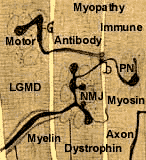Neuromuscular disease is a very broad term that encompasses many diseases and ailments that impair the functioning of the muscles, either directly, being pathologies of the muscle, or indirectly, being pathologies of nerves or neuromuscular junctions.
Neuromuscular diseases are those that affect the muscles and/or their direct nervous system control. In general, problems with central (or upper motor neuron) nervous control can cause either spasticity (from upper motor neuron conditions) or some degree of paralysis (from both lower and upper motor neuron disorders, upper motor neuron conditions usually being associated with concurrent hyperreflexia), depending on the location and the nature of the problem. A large proportion of neurological disorders leads to problems with movement. Some examples of central (or upper motor neuron) disorders include cerebrovascular accident (stroke), Parkinson's disease, multiple sclerosis, Huntington's disease (Huntington's chorea) and Creutzfeldtâ€"Jakob disease. Spinal muscular atrophies are disorders of lower motor neuron while amyotrophic lateral sclerosis is a mixed upper and lower motor neuron condition. Neuropathies involve dysfunction of the peripheral nerves, which consist of: motor neurons, which carry the electrical signals directly from the spinal cord and brain stem to activate muscle movement; the sensory neurons which convey sensory information such as pain, temperature, light touch, vibration and position to the brain; and the autonomic neurons which go to the internal organs and control blood vessel reflexes. Myasthenia gravis and Lambertâ€"Eaton syndrome are examples of neuromuscular junction disorders. Muscular dystrophies and inflammatory myopathies such as polymyositis are examples of primary muscular (myopathic) disorders.
Symptoms and testing

Symptoms of muscle disease may include muscular weakness, rigidity, loss of muscular control, myoclonus (twitching, spasming), and myalgia (muscle pain). Diagnostic procedures that may reveal muscular disorders include direct clinical observations. This usually starts with the observation of bulk, possible atrophy or loss of muscle tone. Neuromuscular disease can also be diagnosed by testing the levels of various chemicals and antigens in the blood, and electromyography (measuring electrical activity in muscles). Diagnostic imaging may be helpful in certain cases, such as those caused by strokes or tumors.
Causes, including autoimmune diseases and poisoning

Neuromuscular disease can be caused by circulatory problems (stroke, etc.), immunological and autoimmune disorders, the failure of the electrical insulation surrounding nerves myelin, genetic/hereditary disorders, such as Huntington's disease, certain rare tumors, the failure of the connections between the nerves and the muscle fibers, exposure to pernicious environmental chemicals, poisoning (including heavy metal poisoning), and importantly, unknown causes. The failure of the electrical insulation surrounding nerves, the myelin, is seen in certain deficiency diseases, such as the failure of the body's system for absorbing vitamin B-12, and also the failure of the myelin is seen in multiple sclerosis and some other neurological diseases, especially in autoimmune diseases that are thought to attack the myelin.
Some neuromuscular diseases are hypothesized to be caused either by viral infections or by attack by little-known pernicious proteins called prions.
Diseases of the motor end plate include myasthenia gravis, a form of muscle weakness due to antibodies to the acetylcholine receptor, and its related condition Lambert-Eaton myasthenic syndrome (LEMS). Tetanus and botulism are bacterial infections in which bacterial toxins cause increased or decreased muscle tone, respectively.
Myopathies are all diseases primarily resulting in muscular degeneration, rather than affecting the nerves themselves.
Muscular dystrophies, including Duchenne's and Becker's, are a large group of diseases, many of them hereditary or resulting from genetic mutations, where the muscle integrity is disrupted. They lead to progressive loss of strength and decreased life span.
Inflammatory muscle disorders

- Polymyalgia rheumatica (or "muscle rheumatism") is an inflammatory condition that mainly occurs in the elderly; it is associated with giant-cell arteritis. It often responds dramatically to glucocorticoids (e.g. prednisolone).
- Polymyositis, dermatomyositis and inclusion body myositis are autoimmune conditions in which the muscle is affected.
- Rhabdomyolysis is the breakdown of muscular tissue due to any cause. While it may not lead to any muscular symptoms at all, the myoglobin thus released may cause acute renal failure.
Tumors

Tumors of muscle are of the soft tissue sarcoma group and include:
- Smooth muscle: leiomyoma (benign, very common in the uterus), leiomyosarcoma (malignant, very rare)
- Striated muscle: rhabdomyoma (benign) and rhabdomyosarcoma (malignant) - both very rare
- Metastasis from elsewhere (e.g. lung cancer)
Smooth muscle has been implicated to play a role in a large number of diseases affecting blood vessels, the respiratory tract (e.g., asthma), the digestive system (e.g. irritable bowel syndrome) and the urinary tract (e.g., urinary incontinence). These disease processes are not usually confined to the muscular tissue. In general, muscle tumors are rare, since muscle cells are not constantly dividing cells.
Tumors of the thymus gland are implicated in some cases of myasthenia gravis and other neuromuscular diseases.
Tumors of the peripheral nervous system are known, but rare, because nerve cells are not ones that divide very much under normal circumstances.